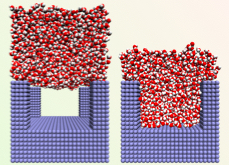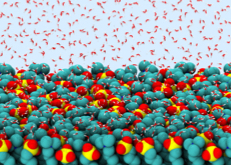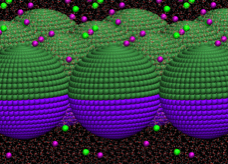Superhydrophobic Surfaces and Water-Harvesting Devices



By understanding the molecular underpinnings of solvation (of water and other liquids) adjacent to complex nanoscopic surfaces, that is, surfaces with nanoscopic pattern and/or texture, our goal is to inform the design of the next generation of advanced materials.
One example is the design of robust superhydrophobic surfaces (left). Surface texture can transform hydrophobic surfaces into "superhydrophobic" surfaces, endowed with properties like water-repellency, self-cleaning, and fouling resistance. However, superhydrophobicity is fragile, and depends on water being excluded from the surface texture. Thus, fully realizing its promise requires an understanding of the underpinnings of wetting-dewetting transitions on nanotextured surfaces.
Other examples of interest to our group include the design of superhydrophilic surfaces with superior protein non-fouling properties (center), nanoparticle membranes for desalination (right), and polymer electrolytes for batteries.
- Relevant Publications
- S Prakash, E Xi, and AJ Patel, Spontaneous Recovery of Superhydrophobicity on Nanotextured Surfaces, Proceedings of the National Academy of Sciences, 113, 5508-5513 (2016).
- Current People
- Zac Vicars
- Lilia Escobedo
Self Assembly in Liquid Crystalline Media
As part of the Penn MRSEC, we are exploring the use of liquid crystalline (LC) solvents to drive the tunable and reconfigurable self-assembly of nanocrystalline (NC) particles with interesting optical and/or plasmonic properties. To sculpt the NC assembly landscape, and organize them into well-defined arrangements, we must first understand how nanocrystals and their functional groups perturb (anchor) the LC solvent in their vicinity.
By combining atomistic simulations and developing novel enhanced sampling techniques, we are working towards a molecular-level understanding of the complex relationship between the chemistry of the NC functional groups and the manner in which as well as the extent to which they polarize the interfacial LC molecules.
- Relevant Publications
- UR Gabinet, C Lee, R Poling-Skutvik, D Keane, NK Kim, R Dong, Z Vicars, Y Cai, AU Thosar, A Grun, SM Thompson, AJ Patel, CR Kagan, RJ Composto, and CO Osuji. Nanocomposites of 2D-MoS2 Exfoliated in Thermotropic Liquid Crystals, ACS Materials Letters (2021).
- Current People
- Aniket Thosar
- Zac Vicars
- Yusheng Cai